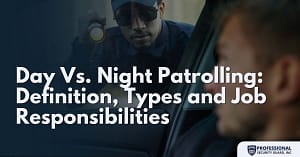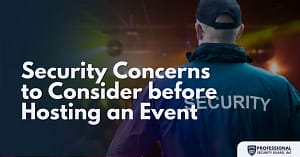Security patrolling is an essential component of any comprehensive security strategy. It involves the regular inspection and monitoring of a designated area by trained security personnel to deter criminal activity, ensure the safety of individuals and property, and provide a quick response to incidents. In this guide, we will explore the importance of patrolling in security, the different types of patrolling, the benefits of patrol security services, integration with other security systems, and who should opt for security patrol services. By understanding the significance of patrolling and its various aspects, you can make informed decisions to enhance the security of your premises.
Importance of Patrolling in Security
Deterrence of Criminal Activity
One of the primary benefits of patrolling is its deterrent effect on criminal activity. The presence of security personnel on patrol serves as a visible deterrent to potential intruders, making them think twice before targeting a property. Criminals are less likely to engage in illegal behavior if they believe they will be caught. This proactive approach to crime prevention can significantly reduce the risk of theft, vandalism, and other criminal acts.
For example, in a residential community where foot patrols are conducted regularly, the chances of break-ins and burglaries decrease significantly. The constant presence of security guards patrolling the neighborhood creates a sense of security among residents and discourages criminals from targeting the area.
Quick Response to Incidents
Another crucial aspect of patrolling in security is the ability to respond quickly to incidents. Security patrols can provide immediate assistance in emergency situations, such as fires, medical emergencies, or security breaches. The presence of security personnel on-site allows for faster response times compared to relying solely on external law enforcement agencies.
For instance, in a commercial building with security guards on patrol, any signs of a fire or suspicious activity can be detected promptly. The security personnel can initiate emergency protocols, including evacuations and contacting the necessary authorities, minimizing the potential damage and ensuring the safety of the occupants.
Visibility as a Security Measure
Patrolling enhances the overall visibility of security measures in place, creating a strong deterrent effect. Regular patrols contribute to a sense of vigilance and security within a premises, reassuring both employees and visitors. The visibility of security personnel on patrol sends a clear message that security is taken seriously, making potential criminals think twice before attempting any unlawful activities.
In a retail environment, for example, the presence of security guards patrolling the store aisles can deter shoplifters. The constant vigilance and visibility of the security personnel act as a deterrent, significantly reducing the occurrence of theft and improving the overall security of the establishment.
Types of Patrolling
Security patrolling can take various forms depending on the specific needs and requirements of the premises. The three main types of patrolling are foot patrols, vehicle patrols, and technology-assisted patrols.
Foot Patrols
Foot patrols involve security guards physically patrolling an area on foot. They allow for a more thorough inspection of the premises, enabling guards to detect any signs of suspicious activity or potential security breaches. Foot patrols are particularly effective in areas with limited vehicle access or where a more personal and interactive approach to security is necessary.
During foot patrols, security guards can interact with employees, residents, and visitors, fostering a sense of community and providing a visible presence that enhances security. This type of patrolling is commonly used in residential communities, shopping centers, and educational institutions.
Vehicle Patrols
Vehicle patrols utilize marked security vehicles to cover larger areas efficiently. Security guards conduct patrols by driving through designated routes, checking for any signs of unauthorized access, suspicious activity, or security breaches. Vehicle patrols are especially beneficial for properties with extensive grounds, such as industrial complexes, commercial parking lots, or large residential areas.
The presence of a marked security vehicle not only acts as a visible deterrent but also enables security guards to respond quickly to incidents or emergency situations. Vehicle patrols allow for a rapid and efficient response, ensuring the safety and security of the premises.
Technology-Assisted Patrols
Technology-assisted patrols involve the use of advanced surveillance technologies, such as drones, cameras, and sensors, to monitor and patrol an area. These technologies can supplement or enhance traditional foot or vehicle patrols, providing additional coverage and surveillance capabilities.
Drones equipped with cameras can be used to monitor large areas or inaccessible terrain, providing real-time video feeds to security personnel. Surveillance cameras and sensors installed strategically throughout a premises can detect and alert security personnel to any suspicious activity or breaches. Technology-assisted patrols are particularly useful in areas where physical patrols may be challenging or insufficient.
By combining different types of patrols, security guard companies can create a comprehensive security strategy tailored to the specific needs of each premises, ensuring maximum protection and peace of mind for stakeholders.
The Benefits of Patrol Security Services
Security patrols offer numerous benefits to businesses, residential communities, and public areas. These benefits include enhanced safety and security, prevention of property damage, and peace of mind for stakeholders.
Enhanced Safety and Security
The primary benefit of security patrols is the enhanced safety and security they provide. Regular patrols help to deter criminal activity and ensure a proactive approach to crime prevention. The presence of security personnel on patrol instills a sense of security among employees, residents, and visitors, creating a safe environment.
For businesses, security patrols can help protect against theft, vandalism, and unauthorized access. They provide an additional layer of protection beyond other security measures, such as surveillance cameras and alarm systems. Regular patrols increase the chances of detecting and preventing potential security breaches, reducing the risk of financial losses and damage to property.
In residential communities, security patrols contribute to a safer living environment. They help prevent break-ins, burglaries, and other criminal activities, providing peace of mind to residents. The constant vigilance and visible presence of security guards on patrol act as a deterrent to potential criminals, making the community a less attractive target.
Prevention of Property Damage
Security patrols play a crucial role in preventing property damage. By conducting regular patrols and inspections, security personnel can identify potential hazards or risks that may lead to property damage. They can promptly address issues such as leaks, faulty equipment, or environmental risks, minimizing the chances of significant damage and costly repairs.
In commercial settings, security patrols can also help prevent damage caused by vandalism or unauthorized access. The presence of security guards on patrol can deter individuals from engaging in destructive behavior, protecting the property and assets of the business.
Peace of Mind for Stakeholders
Knowing that security patrols are in place provides peace of mind for stakeholders, including business owners, residents, employees, and visitors. The visible presence of security personnel on patrol reassures individuals that their safety and security are a top priority.
For businesses, having security patrols in place can enhance their reputation and build trust with customers and clients. It demonstrates a commitment to maintaining a safe and secure environment, which can positively impact the perception of the business.
In residential communities, security patrols provide peace of mind to residents, allowing them to feel safe and secure in their homes. This sense of security fosters a stronger sense of community and contributes to a higher quality of life for residents.
Overall, the benefits of patrol security services extend beyond preventing criminal activity. They contribute to the overall well-being and peace of mind of stakeholders, creating a safer and more secure environment.
Integration with Other Security Systems
Patrolling is not a standalone security measure but rather a crucial component that complements other security systems. Integration with other security systems maximizes the effectiveness and efficiency of security measures, providing comprehensive coverage and protection.
Complementing Surveillance Systems
Security patrols enhance the effectiveness of surveillance systems, such as CCTV cameras. While surveillance cameras provide valuable video footage for monitoring and investigation purposes, they have limitations. They can capture incidents but rely on human intervention to respond promptly.
By combining patrols with surveillance systems, security personnel can actively monitor live camera feeds during their patrols. This allows for immediate response to any suspicious activity or security breaches captured by the cameras. Security patrols provide a proactive approach to security, increasing the chances of preventing incidents before they escalate.
Coordination with Alarm Systems
Patrolling is closely coordinated with alarm systems to ensure a rapid response to triggered alarms. Alarm systems, such as intrusion detection systems or fire alarms, provide an early warning of potential threats or emergencies. Security patrols play a critical role in responding to these alarms and taking appropriate action.
When an alarm is triggered, security personnel on patrol can quickly assess the situation and respond accordingly. They can investigate the cause of the alarm, determine if it is a false alarm or a genuine threat, and take the necessary steps to address the situation. This coordinated approach ensures a swift and effective response, minimizing the potential impact of incidents.
Integration with Access Control
Access control systems regulate entry and exit points to a premises, ensuring that only authorized individuals have access. Patrolling works in conjunction with access control systems to monitor and enforce access policies.
During patrols, security personnel can verify the proper functioning of access control systems, ensuring that doors, gates, and other entry points are secure. They can also identify any vulnerabilities or potential breaches in the access control system and take corrective measures. This integration enhances the overall effectiveness of access control measures, providing an additional layer of security.
By integrating patrols with other security systems, businesses and premises can achieve a comprehensive and well-rounded security strategy. The combination of proactive patrolling, surveillance systems, alarm systems, and access control creates a robust security framework, ensuring maximum protection and peace of mind.
Security Patrolling Checklist
To ensure the effectiveness of security patrols, it is essential to follow a comprehensive checklist. This checklist encompasses pre-patrol preparations, during-patrol focus areas, and post-patrol actions. By adhering to this checklist, security personnel can optimize their patrolling efforts and maintain a high level of security.
Pre-Patrol Preparations
- Review patrol route and areas of focus: Before starting a patrol, security personnel should review the designated patrol route and areas that require specific attention. This ensures that no areas are overlooked and potential vulnerabilities are addressed.
- Check patrol equipment: Verify that all necessary patrol equipment, such as flashlights, radios, and documentation tools, are in proper working condition. This includes ensuring that batteries are fully charged and that backup equipment is available if needed.
- Communicate with other security personnel: Coordinate with other security personnel, both on-site and off-site, to share relevant information and ensure a seamless transition of patrol duties. This collaboration enhances the overall effectiveness of security measures.
- Familiarize with emergency protocols: Review emergency protocols and procedures, including evacuation routes, communication methods, and contact information for emergency services. This knowledge prepares security personnel to respond effectively in case of emergencies.
During-Patrol Focus Areas
- Physical security checks: Conduct thorough inspections of entry points, windows, doors, fences, and other physical security measures. Ensure that they are secure and free from any signs of tampering or damage.
- Surveillance monitoring: Monitor live surveillance feeds, paying attention to any suspicious activity or security breaches captured by the cameras. Act promptly if any potential threats are identified.
- Access control verification: Verify the proper functioning of access control systems, ensuring that all authorized individuals have valid credentials and that unauthorized access attempts are detected and reported.
- Incident response: Respond immediately to any incidents, alarms, or emergency situations. Take appropriate action to address the issue, such as contacting emergency services, initiating evacuation procedures, or alerting on-site personnel.
- Interaction with employees or residents: Engage with employees, residents, and visitors during patrols, fostering a sense of community and providing assistance when needed. This interaction promotes a positive security culture and encourages cooperation in maintaining a safe and secure environment.
Post-Patrol Actions
- Report and document findings: Record any observations, incidents, or security breaches encountered during the patrol. Provide detailed reports, including the date, time, location, and description of the event. This documentation serves as a valuable resource for future analysis and investigations.
- Handover to the next shift: Communicate relevant information and findings to the incoming security personnel during shift handover. This ensures a smooth transition and maintains continuity in security measures.
- Equipment maintenance: Clean and inspect patrol equipment, ensuring that it is in good working condition for the next patrol. Replace any worn-out or damaged equipment as necessary.
- Review and improve patrol procedures: Regularly evaluate the effectiveness of patrol procedures and identify areas for improvement. Seek feedback from security personnel and stakeholders to enhance the overall efficiency and impact of security patrols.
By following this comprehensive checklist, security personnel can optimize their patrolling efforts and maintain a high level of security. Regular review and improvement of patrol procedures ensure that security measures remain effective and adaptable to changing circumstances.
Who Should Opt for Security Patrol Services
Security patrol services are beneficial for a wide range of entities and individuals who are seeking to enhance their safety and security. These include businesses and commercial properties, residential communities, and public and recreational areas.
Businesses and Commercial Properties
Businesses of all sizes and across various industries can benefit from security patrol services. Whether it’s a small retail store or a large corporate office complex, security patrols provide an added layer of protection against theft, vandalism, and other criminal activities.
In retail environments, security patrols can help deter shoplifting and protect against inventory shrinkage. The presence of security guards on patrol provides a visible deterrent and reassures customers and employees that their safety is a top priority.
For commercial properties such as warehouses, distribution centers, or manufacturing facilities, security patrols help ensure the protection of valuable assets, equipment, and intellectual property. They also contribute to maintaining a safe working environment for employees, reducing the risk of workplace incidents.
Residential Communities
Residential communities, including gated communities, apartment complexes, and housing developments, can greatly benefit from security patrol services. Patrols help to deter burglaries, vandalism, and other criminal activities, providing peace of mind for residents.
In addition to preventing crime, security patrols in residential communities contribute to a sense of community and promote a safer living environment. The presence of security guards on patrol fosters a sense of security among residents and encourages a proactive approach to maintaining a safe neighborhood.
Public and Recreational Areas
Public areas such as parks, shopping centers, and entertainment venues can also benefit from security patrol services. Patrolling helps enforce rules and regulations, maintain order, and ensure the safety and well-being of visitors.
In recreational areas, security patrols can address potential safety hazards, respond to emergencies, and provide assistance to visitors. They contribute to a positive visitor experience, fostering a sense of security and encouraging repeat visits.
By opting for security patrol services, businesses, residential communities, and public areas can enhance their safety and security measures, providing a safe environment for employees, residents, and visitors.
Conclusion
In conclusion, patrolling is a critical component of security measures, offering numerous benefits to businesses, residential communities, and public areas. It serves as a visible deterrent, enhances safety and security, and promotes a sense of peace of mind for stakeholders.
Different types of patrolling, including foot patrols, vehicle patrols, and technology-assisted patrols, provide versatile solutions tailored to meet individual security needs. These patrols can be integrated with other security systems, such as surveillance cameras, access control, and alarm systems, to create a comprehensive security strategy.
A comprehensive security patrolling checklist ensures the effectiveness of patrols, covering pre-patrol preparations, during-patrol focus areas, and post-patrol actions. By following this checklist, security personnel can optimize their patrolling efforts and maintain a high level of security.
Businesses, residential communities, and public areas can benefit from security patrol services, enhancing safety, preventing property damage, and providing peace of mind for stakeholders. By considering security patrols as part of a holistic security strategy, entities and individuals can create a safer and more secure environment for all.




